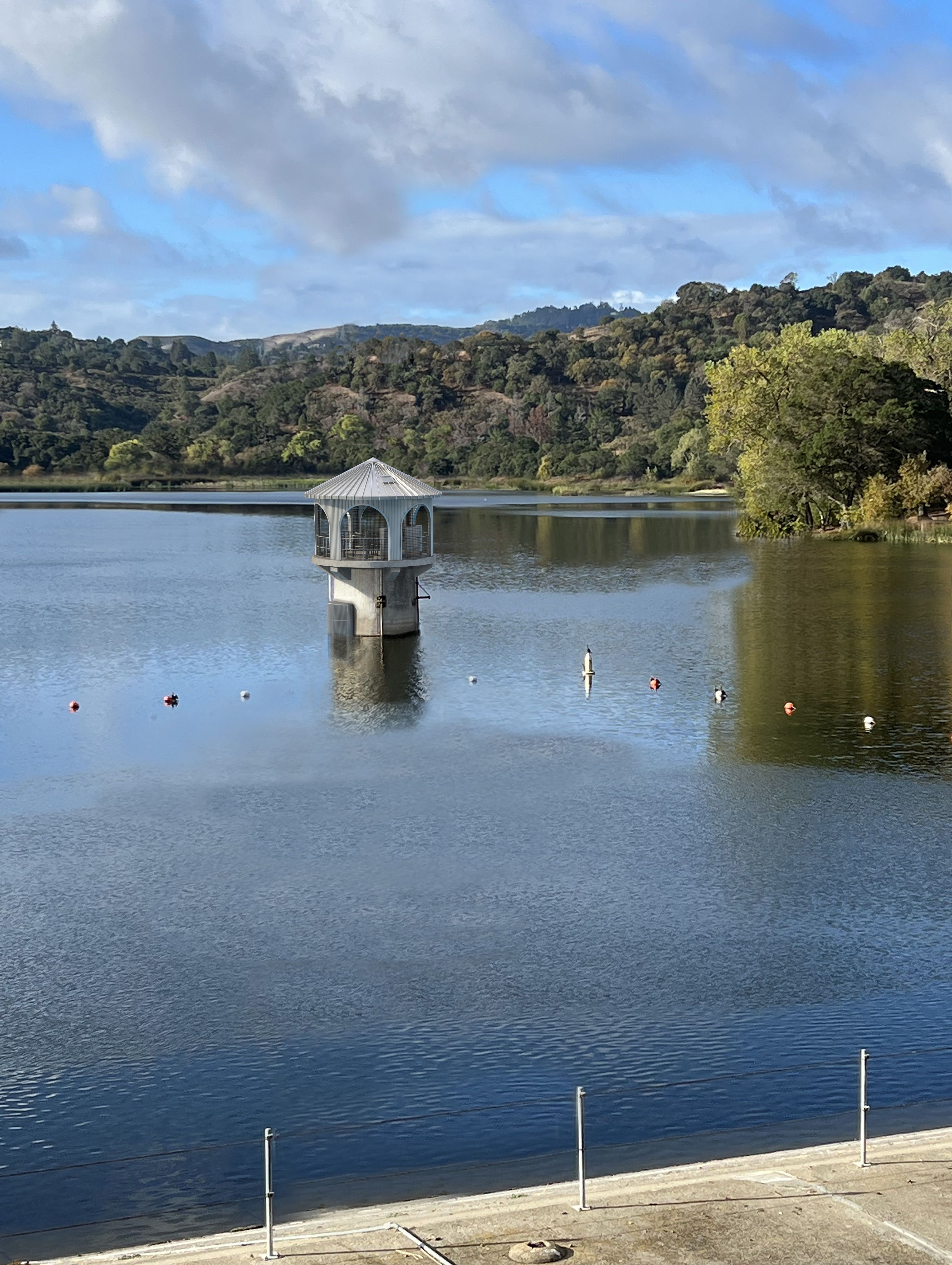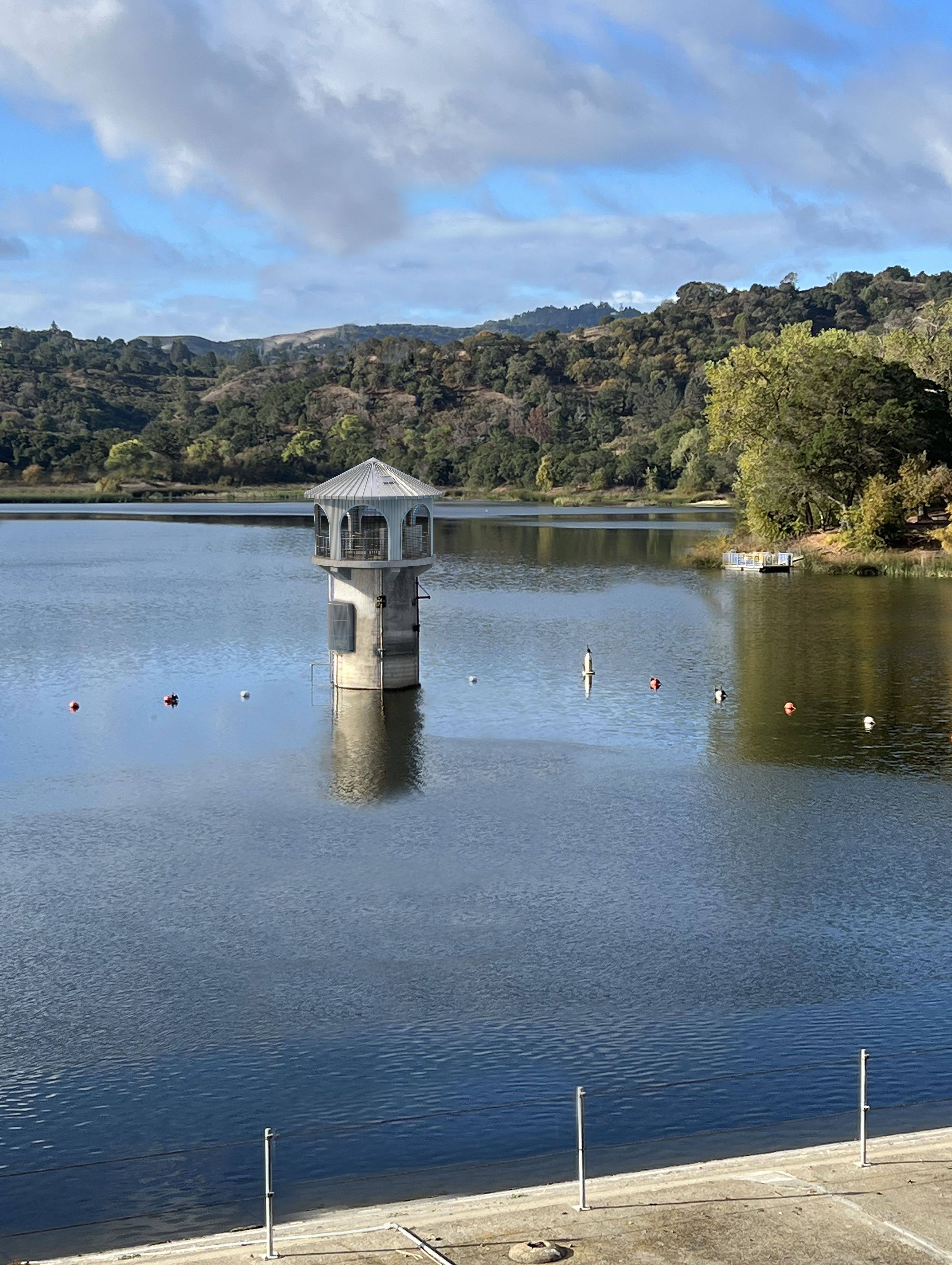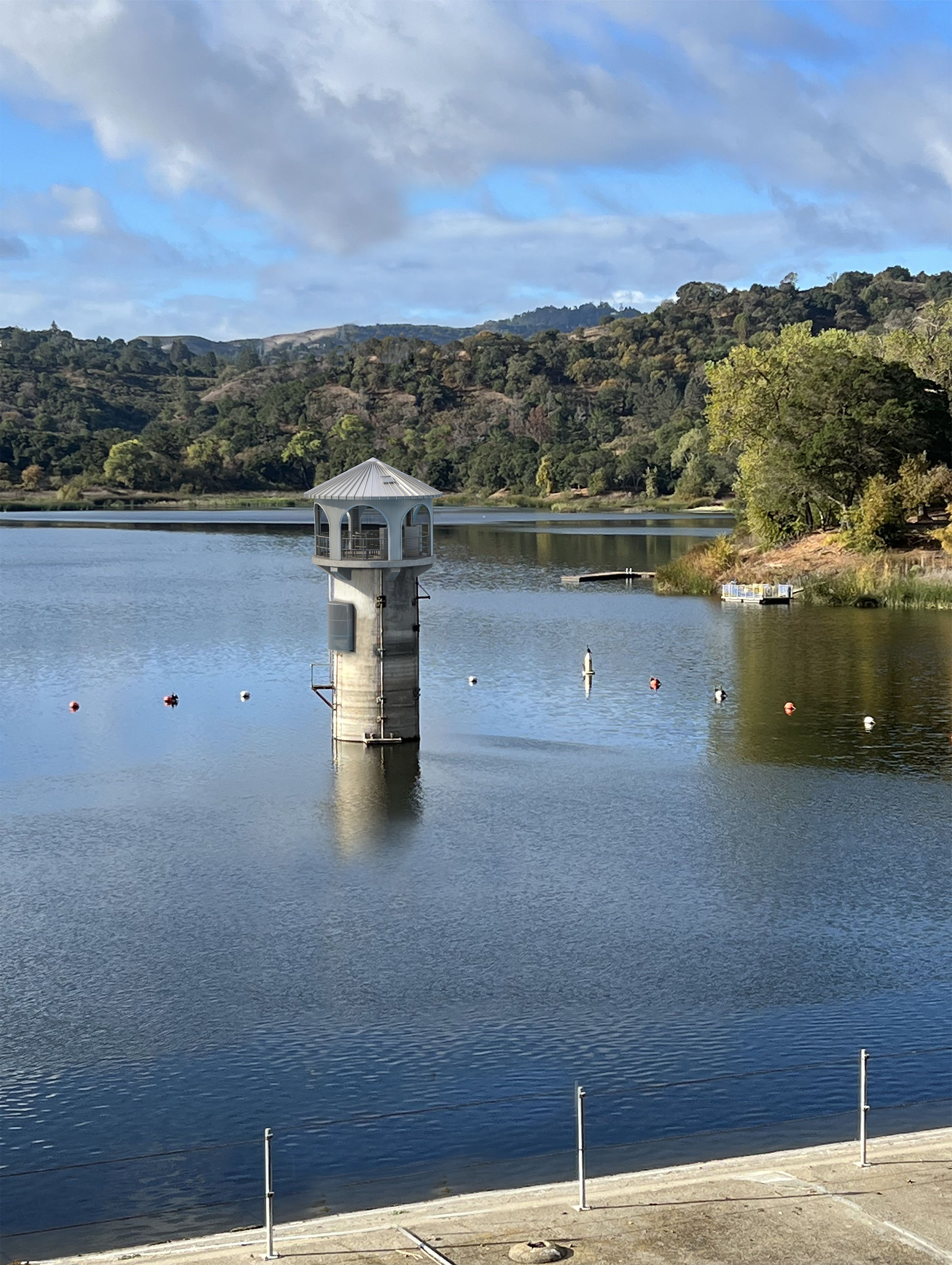On October 9, 2025, EBMUD hosted a community meeting to share information on several upcoming projects at and near the Lafayette Reservoir, including the Lafayette Reservoir Tower Seismic Upgrade. The recording of that meeting is below.
Flowing into the future
Lafayette Reservoir is one of EBMUD's seven reservoirs where we store untreated water. It is a popular recreation area that offers public access to EBMUD’s protected watershed. EBMUD has worked for a decade with expert dam engineers to design a plan to improve the seismic safety of the Lafayette Reservoir Tower while maintaining the existing look. The new tower design will be stronger and safer for today and the future. Below, renderings of the upgraded tower in high, average and low water elevations.
Project update
EBMUD will shorten the tower by 40 feet to fit the height of the dam. There will be no need to drain the reservoir. Minor tree work is anticipated, along with some temporary, localized widening of the access road. This $14 million project is funded by EBMUD rate payers and approved by the California Division of Safety of Dams (DSOD). Additional details are included in EBMUD’s March 2019 Lafayette Tower Alternative Selection Report.
Need for project
EBMUD is the owner and operator of the Lafayette Reservoir and tower. As a public agency, EBMUD is committed first and foremost to public safety. This project is required for earthquake and overall dam safety as determined by the California Division of the Safety of Dams (DSOD), which regulates dams around the state. DSOD considers the tower to be a critical structure for dam safety because it also serves as the spillway, and is the only safe method to drain water from the reservoir. DSOD categorizes the risk downstream of Lafayette as “extremely high", and therefore the safety deficiencies posed by Lafayette Tower must be addressed. Read the full statement.

The map above contains aggregate data from the California Division of Safety of Dams, Google Earth, and other sources. It may be subject to change. To see the DSOD raw data and the full inundation zone, view the Lafayette Reservoir Inundation Map.
Schedule and construction impacts
EBMUD will close the reservoir during key construction periods. Additionally, some parking spaces will be used to store equipment. Follow @ebmud on Facebook, Instagram, X, LinkedIn, and Nextdoor for project updates. Schedule may change pending weather or other circumstances.
- Summer 2025 - Construction planning
- Fall 2025 - Site preparation
- Summer 2026 - Demolition and construction
- Fall 2027 - Project completion
Sign up for construction alerts
Engineering history and increased regulations
This nearly 100-year-old outlet tower is the dam’s spillway. The tower was originally built in 1929 and is 40 feet too high due to a change in the dam height during construction.
Following the Oroville Dam crisis in 2017, DSOD intensified dam safety regulations. Current seismic studies indicate that the Lafayette Tower could bend and break during a large earthquake, which could lead to uncontrolled releases of water inundating Lafayette, Walnut Creek, and many downstream communities. Additionally, the conduits at the base of the tower would also become damaged so that the tower and conduits would not be able to function, causing a dam safety concern.
DSOD has required EBMUD to address the seismic safety of the tower and conduit and to add an onshore valve operating system to improve response time in an emergency.
Contact information
Community Affairs
Email: construction-east@ebmud.com
Phone: 510-287-2053
Frequently asked questions
We’re upgrading the Lafayette Reservoir’s spillway and outlet tower to improve safety and functionality. This project involves shortening the outlet tower, which serves as the spillway for the reservoir and also reinforcing the outlet conduits under the dam to meet modern seismic safety standards. The top of the new outlet tower will feature a metal operating house that closely resembles the existing 100-year-old design, maintaining the historic look while enhancing the tower’s performance and earthquake resilience. This upgrade ensures the tower can effectively manage our reserve water levels and protect the reservoir and surrounding communities. Construction will begin in the Spring of 2025 and last approximately one year
When the Lafayette Reservoir tower and dam construction began in 1927, the original plan was to construct the dam 33 feet taller than what we see today. This would have created a reservoir nearly three times larger. Lafayette Reservoir uses an earth-filled dam, meaning the dam is built by compacting layers of soil to form the embankment. However, during construction, the soil couldn’t support a dam of that height, and the embankment began to move. As a result, the decision was made to lower the height of the dam, but by that time, the outlet tower had already been constructed for the originally planned larger dam. This is why the tower ended up being much taller than necessary for the actual size of the reservoir.
The California Division of Safety of Dams (DSOD) is responsible for ensuring the safety of all dams in the state. Following the Oroville Dam failure in 2017, which led to the evacuation of 188,000 people and caused an estimated $1.1 billion in damage, DSOD intensified its efforts to ensure the structural integrity of dams across California. This included comprehensive evaluations focusing on spillway integrity, seismic stability, and overall dam safety.
EBMUD operates several dams, with all but one receiving a "Satisfactory" rating from DSOD, which is their highest rating. The Lafayette Reservoir was rated "Fair", however, due to its tower and conduit structural vulnerabilities. The oversized tower, built for a taller dam, poses a significant risk in the event of a major earthquake. If the tower were to suffer damage, it could hinder EBMUD’s ability to control water levels in the reservoir, potentially putting Lafayette and downstream communities at risk.
To address these concerns, DSOD has mandated that EBMUD retrofit the tower and conduits under the dam, and has approved tower shortening. This retrofit will ensure that the tower is structurally sound, helping to protect public safety and maintain the reliability of the reservoir.
EBMUD strives to be a good neighbor, and for all projects, works to gather input and inform neighbors and citizens. Throughout this project, EBMUD has engaged with the City of Lafayette and its residents to ensure community input has been considered. Since 2015, EBMUD met with the Lafayette City Council seven times to provide updates and discuss the project and presented to the Lafayette Rotary and Chamber of Commerce to raise awareness and share information with the broader community.
In 2017, EBMUD presented three design alternatives to the City Council, two of which maintained the tower’s height. The shortened tower alternative was then described as the most straightforward approach to address seismic safety hazards, with then-Mayor Anderson expressing favor for the shortened design, suggesting lightweight design elements to preserve the tower’s iconic appearance. Ultimately, EBMUD incorporated this feedback, and additional community feedback into the final design, which includes an operating house resembling the original structure. You can view that Council discussion here.
As the project progressed, EBMUD advertised a community meeting in July 2023 (simulcast on Zoom) to inform residents during the earlier design phases. Despite robust outreach—including social media posts, direct emails to EBMUD Lafayette subscribers, posters on the paved trail, and announcements in the City’s newsletter—the meeting was canceled at the City’s request to allow the City to form its Citizen’s Advisory Committee. EBMUD subsequently delayed the project by over a year, working closely with the Advisory Committee to analyze their proposed tower concepts.
EBMUD’s engineers and its consultants, with extensive backgrounds in the design and remediation of dam structures in conformance with state and federal safety codes, carefully evaluated the Committee’s concepts, ideas, and proposals. While the Citizen’s Advisory Committee brought important perspectives to the discussion, with expertise in building structures and materials codes, unfortunately, their concepts did not meet California Division of Safety of Dams (DSOD) requirements.
To provide additional technical assurance, DSOD met with City representatives in August of 2024 where DSOD presented its own independent analyses of the tower. Their findings concluded that shortening the tower was a safe and appropriate alternative. DSOD engineers and management also addressed questions from the City and its Advisory Committee during the meeting. At that meeting, it was noted that the City’s proposed retrofit concepts likely would not meet the rigorous safety standards required for critical infrastructure like the tower—a conclusion also supported by EBMUD’s independent structural analysis.
In a follow-up letter to the City in November 2024 (linked below), DSOD reaffirmed its design criteria and limited the scope of alternatives. Their letter stated:
“DSOD would consider limited alternate remediation options if proposed by EBMUD; however, since the tower serves as both an outlet and spillway, it is a critical structure for dam safety and any innovative remediation proposed must have a dam-specific record of proven performance. EBMUD has fully evaluated numerous remediation alternatives, including some innovative designs to preserve the top of the tower, but those designs were found to be inadequate. Also, uncertainty as to the as-built condition of the 91-year-old tower may preclude innovative remediation alternatives.”
Over the past three decades, EBMUD has performed extensive analyses and has advanced at least three alternatives that would have maintained the full height of the tower, which ultimately were not approved by DSOD.
In order to respond to the city’s concerns, EBMUD delayed the seismic upgrade to the Lafayette Tower for more than a year and spent more than $500,000 and extensive staff time reevaluating the advisory committee’s concepts and engaging with the community to ensure transparency and collaboration.
The project to shorten and retrofit the Lafayette Reservoir tower is guided by comprehensive engineering and safety analyses. Here's how we ensure its effectiveness:
Detailed Engineering Studies: Before initiating the project, EBMUD conducted years of extensive engineering studies to assess the structural deficiencies of the current tower. This involved state-of-the-art modeling and simulations to understand how the tower would perform during an earthquake.
Regulatory Oversight: The California Division of Safety of Dams (DSOD) is the state agency responsible for overseeing dam safety. After the Oroville Dam crisis in 2017, there has been increased scrutiny of dam projects. EBMUD’s project plans are reviewed and approved by DSOD to ensure they meet stringent safety and design standards.
Expert Consultation: EBMUD is working with experienced consulting engineers and scientists from AECOM who specialize in dam safety and seismic retrofitting. These experts ensure that the proposed modifications are based on the latest industry practices and research.
Testing and Compliance: The retrofit involves reducing the tower height and strengthening the conduits under the dam so that they can safely withstand seismic forces. This work will be done in accordance with strict dam safety codes and regulations to ensure that it effectively mitigates risks.
Overall, the project is designed to enhance the safety and functionality of the reservoir by addressing known vulnerabilities and ensuring compliance with the latest regulatory safety standards. This approach helps safeguard the community and maintain the reservoir's reliability as a critical water resource.
While we cannot predict when the next major earthquake will happen, EBMUD and other critical service are prepared for emergencies, and we improve the water system of today to face the challenges that will come in the next 100 years. Some notable events have guided the decision-making process to this point:
The population of the East Bay Area began expanding after the devastating earthquake of 1906 left major portions of San Francisco uninhabitable.
The Loma Prieta earthquake in 1989 highlighted the need for more seismically-sound infrastructure.
The failure of the Oroville Dam in 2017 triggered a slew of updated dam safety regulations.
The Moraga Fault, which runs under Lafayette Reservoir, last had a major earthquake strike in 1956 which registered a magnitude 5.2. The fault is part of the overall Hayward Fault System, which is capable of a magnitude 7.25 earthquake in the region, with significant seismic forces expected at the location of the tower.
To stay informed about all updates on construction, please ensure you are signed up for EBMUD alerts and follow us on our social media channels. Register for notifications about construction updates and more at EBMUD Alert Subscriptions.
For safety, temporary restrictions may be put in place. EBMUD will coordinate with special event organizers when applicable.
During construction, park-goers will notice activity that could temporarily impact the water level in the reservoir. However, when complete, EBMUD will allow the reservoir to naturally refill to normal levels.
Please note, while our EBMUD rangers onsite are informed about the project, they may not have all the answers to technical questions. Those questions can be referred to project engineers by emailing Community Affairs Representative Joe Voelker at Joseph.Voelker@ebmud.com.
As required by California Water Code section 6161, the Department of Water Resources (DWR), Division of Safety of Dams (DSOD) reviews and approves inundation maps prepared by licensed civil engineers and submitted by dam owners for extremely high, high, and significant hazard dams and their critical appurtenant structures. Inundation maps are not required by the California Water Code for the low hazard dams. Inundation maps are based on a hypothetical failure of a dam or critical appurtenant structure and the information depicted on the maps is approximate. Areas to be evacuated in the event of an actual failure of a dam or critical appurtenant structure are determined by emergency managers.
Inundation maps approved by DSOD are used to develop emergency action plans, and the maps are intended to provide general information for emergency planning and response.
DWR assumes no legal responsibility resulting from the use of this information. Actual evacuation zones and timing will be determined by local emergency managers who are responsible for specific evacuation procedures in an emergency event.


